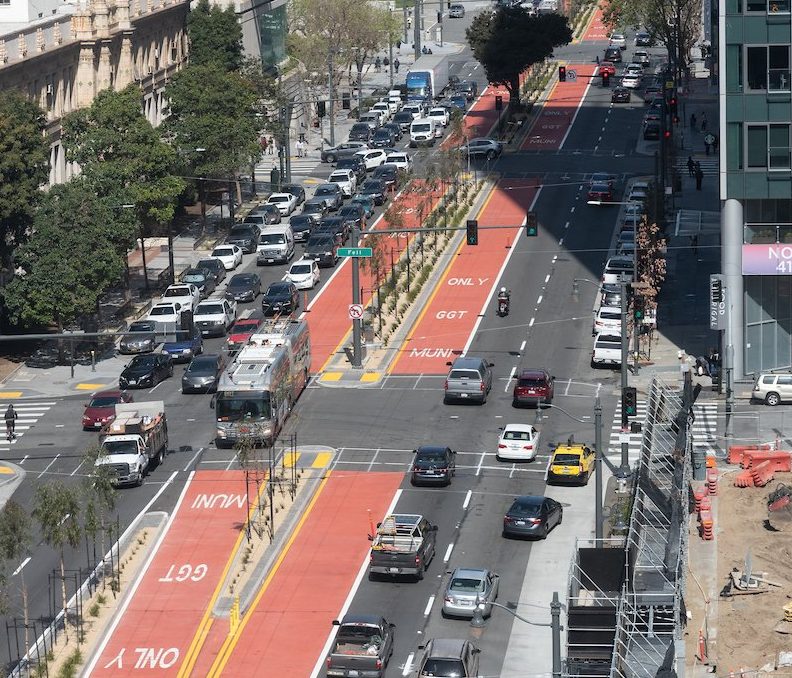The San Francisco Transit Riders asked Streetsblog to publish this reflective post on Friday's launch of the long-awaited Van Ness transit-only lanes and street improvement project.
The new Van Ness Avenue bus rapid transit (BRT) system will reduce travel times by 32 percent on Muni Routes 47, 49 and 90 and on Golden Gate Transit routes that operate in the corridor. San Francisco Transit Riders has been a strong advocate for Van Ness BRT since our inception in 2010. We’re excited to celebrate the completion of this historic transit project that will operate between North Point and Market Street. As a member of the Van Ness Community Advisory Committee and Vice Chair of the San Francisco Transit Riders, here’s my inside scoop on the project.
The History of Van Ness BRT
Named after San Francisco’s seventh mayor, Van Ness Avenue is a major north-south corridor that serves the city’s major civic and cultural institutions including City Hall and San Francisco’s Symphony, Ballet, and Opera House. Van Ness also consists of a major commercial district with movie theaters, car dealerships, and a wide range of small to midsize stores. The boulevard serves as the front door for high density residential buildings for families, students, and retirees. And most city residents and commuters use Van Ness as a major transportation artery that serves as US 101 through the city and the primary interregional bus corridor that connects San Francisco to Marin County and the North Bay.
Over time, heavy traffic along the corridor began to significantly increase travel times on local and regional buses. San Francisco political leaders, planners, and engineers agreed on the need for major investment to support reliable, efficient public transit service for residents and commuters who travel on Van Ness.

There are three volunteer committees associated with the project: the Van Ness Citizens Committee, a business advisory council, and SFMTA‘s Citizens’ Advisory Council. I joined the Van Ness Citizen Committee in 2017 when the BRT project was first breaking ground after several years of planning. I live four blocks from Van Ness, and as a board member with San Francisco Transit Riders, I hoped I could bring a rider’s perspective to the process. The meetings were interesting and informative. We learned so much about what makes Van Ness special, including its role as a firewall during the 1906 earthquake, which destroyed much of the eastern part of SF along with iconic architecture on Van Ness.
The Geary Boulevard BRT project was also well underway while the Van Ness project was under construction, and SFTR advocates and members also serve on the Geary BRT committee. SFTR’s contributions to the Van Ness and Geary BRT projects is a major accomplishment towards SFTR’s 30x30 vision campaign to speed up transit trips and expand transit access.
Why the project will benefit riders
Bus Rapid Transit on Van Ness is part of Muni's Rapid Network that prioritizes investments to increase frequency and reliability. In addition to separated, dedicated bus lanes, traffic signal technology will give buses the green light. New pedestrian infrastructure includes improved sidewalks, bulb-outs, crosswalk signals, and dedicated ADA-accessible median platforms.
Platforms and boarding islands provide seating and real-time bus information. The Van Ness BRT supports improved connections with Muni’s rapid network at Market Street, McAllister Street, and Geary Street.
Lessons learned from the project
Delivering a project as complicated as the Van Ness BRT was a major effort for all involved. The project exceeded its original cost estimates, took much longer to complete than anticipated, and has been a source of controversy for some residents and business owners.
The Van Ness BRT has had more than its share of frustrations, delays, and cost overruns from extensive underground work due to additional contract negotiations and inconsistent availability of contractors to do the work. The City needed to replace water and sewage infrastructure from the 1800s and meet strict environmental requirements due to excavating archaeologically significant artifacts dating from before the 1906 earthquake. Above ground, SFMTA needed to address residents' concerns about tree removal, light posts, and historic preservation of the street and sidewalk.

Along with other committee members, I shared these details with nearby residents and advocates and we were able to bring important community concerns to SFMTA. I came to very much appreciate the efforts of SFMTA staff to keep the project on track and conduct public outreach. Yet, much of the project schedule was outside their control. For many regular riders, emails, signage, and other notices did little to mitigate the frustration of frequent changes. Relocating bus stops is inevitably unpopular. Construction is really difficult for local businesses and residents. The citizens committee extended the public outreach efforts and helped develop strategies to reduce the impacts of the ongoing construction.
SFTR has long advocated for bus rapid transit and other improvements on Van Ness, and our participation has helped make this a better project. We provided input on project design, stop placement, pedestrian safety/accessibility, and messaging and provided regular updates to our members and partners. One of SFTR’s major contributions was to strongly resist efforts in the final stages of project design to abandon the center lane configuration in favor of side lanes (similar to the Geary quick-build). Side lanes would have put Van Ness buses back in the mix with US 101 congestion.
We celebrate the long-awaited opening, the travel time improvements for bus riders, and the separation of buses from an otherwise congested street. We will measure the project’s success in terms of rider satisfaction and service performance, and we will continue to ride along and listen to all those who rely on public transportation.
Steve Pepple is the Vice Chair of San Francisco Transit Riders Board of Directors and a member of the Van Ness Community Advisory Committee.





